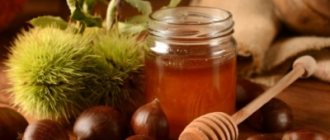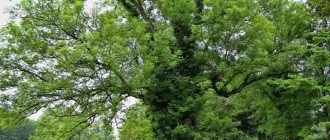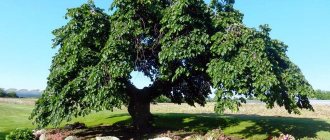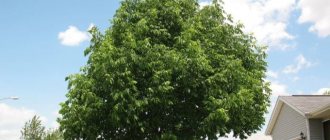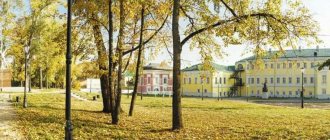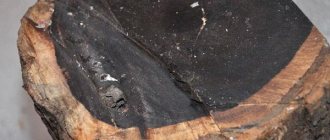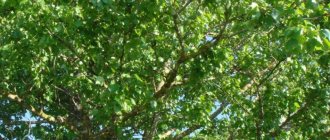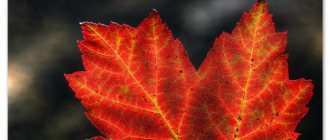Spreading
Native to eastern North America, from Nova Scotia and southern New Brunswick south to Tennessee and Virginia and along the Appalachian Mountains to northern Georgia, eastern Nebraska and central Kansas; most abundantly found in the forests of Canada - Nova Scotia, southern Quebec and Ontario. It grows in forests, reaching its largest sizes on glacial moraines and along river banks, where there is no stagnation of water in the soil. [4] .
Often bred in the USA, in culture since the 17th century in England, France and Germany.
In Russia it has been known in culture since the beginning of the 19th century. The oldest individuals grow in St. Petersburg - in the Botanical Garden and the Park of the Forestry Academy, where they bear fruit abundantly, and in the latter form significant self-seeding. [5] Winter-hardy and grows well in the Moscow and Oryol regions. It winters in Rostov-on-Don, but does not bloom. It is found in the North Caucasus, as well as in Yekaterinburg, but large branches freeze here. Known in Estonian parks, where it bears fruit. It grows well throughout Belarus, self-seeding is observed. Distributed throughout Ukraine, including in forest plantations.
Botanical description
A mature tree reaches 25 m in height. The tree is slender, with a dense tent-shaped crown. The trunk is covered with thin, smooth, gray bark; in old trees the bark cracks. It has a well-developed root system that grows deep. Young shoots are reddish-felt, annual shoots are reddish-brown, smooth.
The leaves are deeply notched, thin, shiny, up to 15-25 cm, with four to five pointed lobes on each side of the leaf, reddish when blooming, dark green in summer, lighter below, scarlet-red in autumn, before falling, in young trees, in older ones they are brownish-brown.
It blooms simultaneously with the leaves blooming.
Acorns are spherical in shape, up to 2 cm, red-brown, as if chopped off at the bottom, ripen in the fall of the second year. Fruits steadily and abundantly from 15-20 years. Acorns do not germinate until spring, so squirrels often hide them for the winter [6].
Frost-resistant. Moderately light-loving, easily tolerates lateral shading, but prefers full illumination of the crown top. Wind-resistant, not very demanding on soil fertility, even withstands acidic reactions, but does not tolerate calcareous and wet soils. Resistant to pests and diseases, including powdery mildew. Susceptible to leafminer. Has high phytoncidal properties.
Wood
Red oak sapwood ranges from white to light brown in color; the heartwood is a pinkish, red-brown color. In appearance, red oak is similar to white oak, the difference lies in less pronounced patterns due to shorter rays. The wood has a straight grain and a rough structure. The dry density of red oak wood is 790 kg/m³.
Red oak wood can be machined and is highly polished.
Application
Production of lumber, veneer, furniture production, flooring production.
Source: sadovodoptmkad.ru
About our “maple” or holly oak
Slender tree up to 25 m tall, with a dense tent-shaped crown. The trunk is covered with thin, smooth, gray bark, cracking in old trees. Young shoots are reddish-felt, annual shoots are reddish-brown, smooth. The leaves are deeply notched, thin, shiny, up to 15-20 cm, with 4-5 pointed lobes on each side of the leaf, reddish when blooming, dark green in summer, lighter below, scarlet-red in autumn, before falling, in young trees, in older ones they are brownish-brown. It blooms simultaneously with the leaves blooming. Acorns are spherical in shape, up to 2 cm, red-brown, as if chopped off at the bottom, unlike pedunculate oak, they ripen in the fall of the second year. Fruits steadily and abundantly from 15-20 years.
Frost-resistant, can be used for planting from the latitude of Moscow and further south. Moderately light-loving, easily tolerates lateral shading, but prefers full illumination of the crown top. Wind-resistant, not very demanding on soil fertility, even withstands acidic reactions, but does not tolerate calcareous and wet soils. Resistant to pests and diseases, including powdery mildew - the scourge of our oaks. Has high phytoncidal properties. The advantages of red oak include its resistance to smoke and gases. Belongs to breeds that effectively reduce city noise. Due to its high decorative value, resistance to adverse environmental factors, and magnificent autumn decoration, it deserves the widest use in green construction, for creating single and group plantings, alleys, arrays, lining roads and streets. In culture since XVII
Red oak (Quercus rubra), can be found under the names holly oak or Canadian oak. This is a large, fast-growing, durable tree reaching a height of 25 meters. In its homeland in the United States, red oak is of great forestry importance. Its heavy hardwood has a beautiful amber color with a reddish tint and is used to make boards, furniture, and plywood.
Red oak is quite hardy in Northwest conditions. In severe winters, the ends of young branches may freeze. Tolerates city conditions well. Moderately shade-tolerant, but grows best in full light. Prefers well-drained acidic soils. It grows poorly on calcareous soils and does not tolerate stagnant moisture. Red oak is resistant to pests and diseases. Not affected by powdery mildew.
The crown of red oak is dense, tent-shaped or broadly ovoid. The bark is thin gray. The leaves of red oak differ from the usual pedunculate oak, large, up to 23 centimeters long, 3–5 lobed (the blades are pointed). They vaguely resemble the leaves of Norway maple. When blooming, the leaves of red oak are reddish, in summer they become dark green, and in autumn they acquire a spectacular color - in young plants the leaves are bright red, in adults they are brown with a reddish tint. Red oak gets its name from the fall color of its leaves.
Red oak is used for single and group plantings, creating alleys; it is suitable for planting along roads and streets, as it is highly gas-resistant. This tree is not suitable for small areas as it grows quickly and grows to a large size.
Red oak is propagated by seeds; collected acorns are sown in autumn or spring after stratification.
Source: murrrc.livejournal.com
What kind of wood is oak maple?
Oak
not too common in Russia.
In Moscow
There are only two places where there are really a lot of these trees: the Dubki Park and the Terletskaya oak grove.
Oak
(lat. Quercus) is a genus of trees and shrubs of the Beech family (Fagaceae). The genus includes about 600 species.
In terms of life expectancy, oak is one of the first places in the plant world.
In Russia
only one species is significantly widespread -
English oak
with two varieties:
- summer oak - blooms in mid or late spring,
- winter oak - blooms at the beginning or end of summer.
The oak is well recognizable thanks to its fruits, acorns,
English oak or common oak (Quercus robur)
English oak reaches a height of 20-40 m. It can live up to 2000 years, but usually lives 300-400 years. Growth in height stops at the age of 100-200 years; growth in thickness, although insignificant, continues throughout life.
White maple or sycamore
1 - tip of the shoot in winter: 2 - cluster of flowers; 3 - female flower; 4 - male flower; 5 - bisexual flower; 6 — cross-section of a two-locular maple ovary, with two testicles in each socket; 7 - mature dipteran; 8—diptera, from one half of which part of the wall has been removed to reveal the seed enclosed in it; 9 - seed embryo; 10 - cross-section of the embryo along the line a - b, on which the root (a) and folded cotyledons are visible; 11 - sycamore shoot.
In Russian the word sycamore
serves as a popular name for various types of maple.
Sycamore was the legendary material from which harp was made. A stable epic expression: “ Guselki are spring-fed”
” originally meant “made from sycamore.” Currently, Maple is the main wood for guitar building.
Sycamore maple
- in the ancient legends of the Western and Eastern Slavs, a tree into which a person is turned (“sworn”). For this reason, the maple tree is not used for firewood (“sycamore came from man”), maple leaves are not placed under bread in the oven (five fingers are seen in a maple leaf), and a coffin is not made from it - “it is a sin for a living person to rot in the ground.” ) etc.
Genus maple
(Acer) unites about 150 species of deciduous trees and shrubs, of which
about 25 species of maple can be found Russia
On Russian
Several types of maples grow, mainly in the middle zone and the Caucasus:
- Norway maple (or common maple),
- sycamore,
- Tatar,
- American.
There are more than one and a half hundred species of maples in the world - most of all in Southeast Asia and North America. A maple leaf adorns the flag of Canada
- the tree has become a symbol of this forest, maple-rich country.
Source: mooseum.ru
Which tree has leaves similar to oak leaves? Community of little green men
People have revered the mighty oak tree since ancient times.
For the ancient Greeks, it was a symbol of longevity, mental and physical strength, so wreaths made from oak leaves were considered the best reward for brave warriors. The largest and largest trees symbolized Zeus and were his natural monuments. Oaks are deciduous trees from the beech family. The oak genus includes about six hundred species of plants, which can be seen in all regions of the Northern Hemisphere where a temperate climate prevails. The southernmost distribution of this plant is in the tropical highlands, although some species grow near the equator, in Bolivia and the Greater Sunda Islands.
Most representatives of the genus are light-loving (although there are species that prefer to grow in partial or full shade), resistant to frost and drought, undemanding to the composition of the soil and can grow on dry, acidic and even saline soils.
The oldest representative of the genus
The mighty oak is a long-lived plant: the age of the oldest oak in Europe ranges from 1.5 to 2 thousand years.
At the same time, it is not tall: the height of the tree does not exceed 25 meters, but the diameter at the level of one and a half meters from the surface of the earth reaches four.
An old oak tree grows in Latvia, not far from the village of Stelmuzh, which is where its name comes from - “Old Man of Stelmuzh”. Interestingly, there used to be a huge hollow inside the tree, due to which the old oak could have died. To prevent this, the hollow was cleared of debris, which required several dump trucks to remove, disinfected, and the holes were sealed with copper sheets. True, such methods only briefly extended the life of the mighty oak. Its condition is currently close to critical: the oak bark is overgrown with mosses, lichens, fungi, and the likelihood that the old oak will die soon is high.
Description
The average height of an oak tree is 40 m, but you can also find 55-meter giants. The crown of the oak tree has a pyramidal structure, the branches are curved. The roots of the oak tree are strong and go deep underground. The root system consists of the main root; after 6-7 years, lateral shoots appear. The oak trunk is wide, 1.5-2 m in diameter (can reach 4 m), the bark is gray-brown with deep longitudinal grooves. The leaves are a rich green shade, turning yellow-brown in autumn. The oak leaf is leathery, elongated, pinnately lobed. Oak flowers are small and barely distinguishable among the leaves, monoecious, and come in two types: male with earrings whistling from the branches and female in the form of small grains, forming small bunches. The plant blooms in late spring. Oak fruits are acorns up to 3.5 cm long, brown-yellow, immersed in a cup-shaped cap. They ripen in September, later on old trees than on young ones.
Belongs to long-lived and slow-growing breeds, usually lives 400-500 years. The oldest tree is considered to be one that grows in Stelmuzha, Lithuania. The age of oak, according to various sources, is 1000-1700 years.
Evergreen deciduous plants
Coniferous or evergreen deciduous trees are also used in the design of homestead areas. Today there are many varieties of trees and shrubs that are capable of decorating a site with their fresh and bright crown throughout the year.
Rhododendron
More than 600 species of rhododendron grow in the world, some of which are deciduous, and some are evergreen. One of the most popular genera is azalea.
Azaleas are heat-loving, require careful care, they need acidic soil and regular fertilizers.
Boxwood
A slow-growing, unpretentious plant that in Russia grows mainly on the Black Sea coast.
One of the most ancient shrubs used for landscaping. Since boxwood easily tolerates pruning, it is well suited for creating hedges and sculptural compositions.
Euonymus
A small tree with an openwork crown and small leaves that turn into bright and unusual colors in autumn
There are also large varieties, the crown width of which can reach 10 m. Dwarf and creeping varieties are often used in decorating areas, effectively entwining fences and hedges.
Magnolia
An ancient plant that appeared in the Cretaceous period. Natural habitat is East Asia and North America.
Wild magnolia grows on the Russian island of Kunashir. In the southern regions it is used for urban landscaping and planted in private areas.
Main types
About 600 species of oaks are known. The most popular of them is the common oak (Quercus robur). Other names for Quercus robur are English oak and English oak. There are two varieties of English oak growing in Russia: early (blooms in May) and late (blooms after 3 weeks). Common types also include:
- Downy oak (Quercus pubescens) grows in the mountain forests of Crimea, southern Europe and Transcaucasia. It has a stocky trunk, low (up to 12 m on dry soils and up to 18 m on wet soils) and young branches and fruits hanging down. The leaves and tops of acorns are covered with microscopic villi, creating pubescence. Light-loving and drought-resistant.
- Sessile oak (Quercus petraea) is a 35-40 meter deciduous tree with a spreading crown. According to morphological characteristics, it is close to common oak. A distinctive feature is several tap roots. It has a weeping variety with drooping shoots forming spectacular cascades. Grows on southern rocky slopes.
- Red oak (Quercus rubra) is an ornamental tree up to 25 m high; leaves with pointed blades have a reddish tint when they appear, turn green in summer, and become rich red in autumn. Winter-hardy, grows well in the Moscow region, Belarus and Ukraine. Popular in the USA and Europe. Acorns ripen not in one season, like the common oak, but in two.
- Maple oak (Quercus acerifolia) is endemic to the south-central United States and grows as low trees and shrubs. The leaves resemble maple leaves and turn red with the onset of autumn.
- Virginia oak (Quercus virginiana) is a 20-meter tree that remains green throughout the year. It has incredibly dense and durable wood. Distributed in the southern USA.
- Mongolian oak (Quercus mongolica) is a tree with a rounded crown, grows up to 30 meters, is light-loving, and resistant to winds and frosts. Grows in the Far East, China, Japan and Korea. Forms oak forests on rocky slopes.
Also common species are jagged (Quercus dentata) and chestnut leaf (Quercus castaneifolia).
Deciduous trees
Deciduous trees are a necessary attribute for garden compositions. In winter and summer, their structure is different.
Oak is a plant found from the north to the subtropics.
Several varieties also grow in tropical areas.
There are about 600 species in total.
Three types of oak are common in Russia: pedunculate in the European part, rocky in the Caucasus and Mongolian in the Far East.
| View | Description | Leaves |
| Petiolate | It grows throughout all European territories up to the Urals. A light-loving, long-lived plant reaching 40 m in height. Prefers moist soil. Planting of acorns is carried out in autumn or late spring. | Oblong, with small petioles, dense, green. |
| Red | A short North American tree (up to 25 m), preferring light areas with soil of moderate humidity. Lifespan is up to 2000 years. Resistant to diseases, not susceptible to pests. The crown is dense, tent-shaped. | After blooming they are red, later green. In autumn, rich brown or brown. |
| Mongolian | Grows up to 30 m. In the coastal zone it is low and shrubby. Resistant to cold and strong winds. | Dense, with a small petiole, tapering towards the base. |
Acacia
Acacia originated on the North American continent, but is now distributed throughout the globe.
Height up to 25 m, but shrubby trees are often found.
| View | Description | Leaves |
| street | Heat-loving, easily tolerates dry summers, but does not winter well at low temperatures. The flowers are fragrant, white, up to 20 cm. | Unpaired, dark green. |
| Golden | Bush-like, up to 9-12 m. Inflorescences white or yellow. Flowering occurs at the end of spring or the first weeks of summer. | Light green, turns yellow in autumn. |
| Silk (Lenkoran) | A low tree (6-9 m) with a spreading crown. Blooms in mid-summer, flowers are white and pink. | Lacey, blooms late and remains on the tree until November. |
Birch
One of the most common trees in Russia is birch.
In Slavic culture, products made from this plant were endowed with magical properties. In folk and traditional medicine, buds, leaves, and tree bark are used. Birch sap also has healing qualities.
| View | Description | Leaves |
| Dwarf | Western European shrub plant growing in the tundra zone, alpine foothills, and marshy areas. Hardy, winters well in cold weather. | Round, often wider than long. |
| Bolotnaya | The bark is white, turning gray over time. Height up to 20 m. Branches always point upward. Loves moist areas with low sand content in the soil. | Elliptical, small, bright green. |
| Weeping | An elegant plant with a dense umbrella-shaped crown and downward-pointing branches. Unpretentious, resistant to cold winters. | Round, dark green, small. |
Maple is a long-living tree with beautiful foliage that effectively changes color with the onset of autumn. The maple leaf is featured on the national flag of Canada.
Most of the species are of medium height, but there are also shrubby forms. Several varieties of evergreen maples also grow in the Mediterranean.
| View | Description | Leaves |
| Field (plain) | A tree with a straight or slightly curved trunk and a developed root system. Does well in urban environments. | Bright green, five-lobed, in autumn the color changes to yellow, orange, brown, reddish. |
| Globular | Decorative subspecies of maple, bred to decorate parks, alleys, and home gardens. The natural shape of the crown is spherical and does not require pruning of branches. | Sharp, five-lobed, glossy. |
| Red | Popular in Japan, but suitable for growing in the climate of central Russia. | Red, in some species purple or bluish. |
Linden is a plant of the mallow family, which is often planted in cities.
Takes root well in parks. Prefers moist soils, temperate and subtropical climate zones.
| View | Description | Leaves |
| large-leaved | Distributed in Central Russia, it has a widely pyramidal crown. Prefers dark areas. | Oval-shaped, dark green, the underside of the leaf is lighter than the top. |
| Crimean | Suitable for cold regions, unpretentious. The inflorescences are small, yellow-white. | Heart-shaped, rich green color. |
| Small-leaved | It blooms in July for about a month. Can grow in sun and shade. | Small, heart-shaped, with reddish corners. |
Imprints of the oldest willows are found on rocks of the Cretaceous period.
Today there are more than 550 varieties of this plant, some of which grow in the harsh climate of the Arctic. Most common in cool areas.
| View | Description | Leaves |
| Rod-shaped | A small tree with thin, long branches. Flowering occurs in early to mid-spring. | Elongated (up to 20 cm), thin, with soft silky hair on the surface. |
| Silver | Slow growing shrubby plant. | Pointed oval, small, with a silvery tint. |
| Weeping | It grows in Europe and has a conical crown with drooping branches. In spring, greenish, slightly silvery catkins form on the trees. It easily takes root in cities, loves open and bright places. | Narrow, shiny, bluish. |
Alder
In the myths of the Komi people, alder was revered as a sacred tree, and in Ireland, cutting down this plant was considered a crime.
There are up to 40 species of alder in the world, most of which grow in temperate climates.
| View | Description | Leaves |
| Green | A bush-like plant whose habitat is western Europe and the Carpathian Mountains. It can be grown in garden plots with sandy, clay soil. Suitable for latitudes with cold winters. | Small, ovoid, pointed. |
| Golden | Grows up to 20 m. The crown is rounded, sometimes conical. Does not tolerate arid climates well. | Green-golden, turning yellow in autumn. |
| Siberian | It grows in the Far East, preferring areas near rivers or coniferous forests. There are both trees and shrubs. Tolerates severe frosts and does not bloom. | Bright green, small, with pointed ends. |
A tall, spreading tree found in deciduous forests. According to scientists, the first elms appeared on Earth more than 40 million years ago.
Now these plants can be seen in southern forests and parks, in the middle zone. Suitable for growing in gardens.
Spreading
Oak grows mainly in areas with a temperate climate. The plant is not found in Australia and South America, and is poorly distributed in Africa. Natural habitats of the breed: Russia, European countries, North America and Canada. Frost-resistant, which allows you to withstand temperatures down to -35 degrees. It is cultivated in all parts of the globe with the exception of countries with extremely hot climates.
The tree prefers fertile and well-drained soil. It grows in river valleys, ravines, and forms mixed forests with spruce and pure oak groves. Found on sandy, moist soils.
Fruit
Among fruit plants there are both deciduous trees and shrubs and evergreens.
There are hundreds of varieties of fruit plants in the world.
Apple, plum and cherry trees are traditionally grown in Russian regions, but some other trees are also frost-resistant and take root well in the middle zone.
This plant tolerates the harsh winters of Siberia well and does not require troublesome care. Serviceberry berries contain a high content of vitamin C, acids, and tannins.
To obtain a rich harvest, shadberry is planted in an open, sunny place, maintaining a distance between bushes of at least 3 m.
Hazel
Hazel is also known as hazel. An unpretentious, sun-loving shrub that bears fruit in late summer or early autumn. Common hazel nuts are called hazelnuts.
They have high nutritional value, contain valuable oils and are rich in microelements. To increase the yield, replanting is carried out every two years.
Hawthorn
Deciduous bush, less often a low tree. Hawthorn is often grown for decorative purposes, but its fruits are widely used in medicine.
They regulate heart function, help fight shortness of breath and are useful for thyroid diseases.
Honeysuckle
There are more than 200 species of honeysuckle in the world. In the wild, it grows in Asian regions. These plants are trees and shrubs.
Garden honeysuckle is often used for decorative purposes.
Plum, cherry, bird cherry, sweet cherry
These plants are distinguished by beautiful flowering and white or white-pink flowers.
They prefer sunny and open places. In spring they bring sophistication and freshness to the garden, and their fruits are widely used in cooking.
Elder
The most common type is black elderberry, but Marginata and Aurea varieties are more suitable for garden plots.
Elderberry is planted in a sunny place or in light partial shade and propagated by cuttings.
Rowan
Rowan is a low tree of the Apple family, common in Europe and North America. There are up to 100 species, but in Russia the most common mountain ash is the common mountain ash.
Does not require complex care, looks impressive both in summer and autumn. The berries contain trace elements (potassium, copper, iron, zinc, magnesium), vitamins, sugars and amino acids.
Apple tree
In Russian gardens you can find different varieties of apple trees - with white, red, pink fruits. The flowering period occurs in April or May.
Apple trees are propagated by purchasing new trees, which are planted in an open and sunny place.
Peach
Growing peaches is quite painstaking, and the lifespan of this plant is short. They are not suitable for the Moscow region and all central regions.
Peach grows in warm latitudes, producing flowers early in the year - in January or February. The flowering of the tree begins before the first leaves bloom.
Planting and care
The tree is planted in a bright, open place with a distance of at least 4-5 m from other plants and buildings - the branched root system can damage the foundation of buildings. In addition, in the future, a tree with a spreading, dense crown will become a source of shade, so you should not plant in places where this is undesirable. The soil is preferably fertile, rich in minerals, and moderately moist. There are 3 ways to grow a young oak tree: plant an acorn, root cuttings, or purchase a seedling from a nursery.
- Planting an acorn. A simple but long way. It is advisable to germinate and plant in the fall before the onset of cold weather. Nuts are dug in to a depth of 3-4 cm in spring and 6-7 cm during autumn planting. Store in the basement or other cool place until spring. The plant germinates for about a month. To prevent attacks, rodents are covered with spruce branches.
- A seedling from a nursery. Planted in spring, preferably 1-2 year old oak trees grown in a container. The hole should be about 90 cm in depth and diameter. First, add a drainage layer, then a nutrient layer: humus, ash, phosphorus fertilizer, soil. The seedling is removed from the container along with the soil. It is recommended to add potassium fertilizer and secure the future tree with guy wires. The root collar is left at a level of 2 cm above the ground, compacted, irrigated with 10 liters of water, mulched with hay, dry leaves, compost or sawdust.
- Cuttings. Conducted in early June, cuttings from young oak trees take root better.
The plant can be replanted without harm only at an early age. If a tree grows in one place for a long time, its roots grow and deepen and can be damaged when transplanted.
Caring for the plant is simple and consists of regular weed control, loosening and watering. During the first years, the tree needs constant irrigation, which is especially important in the hot summer.
From 2 years of age, it is advisable to feed them with complex fertilizers. Timely pest control and shelter before the onset of frost are also necessary.
Young oak trees attract birds and rodents. To prevent the tree from being damaged, a protection is built - a small fine-mesh fence around the planting.
All types of oak trees require sunlight and regular irrigation. To prevent other plants from taking nutrients from the growing oak tree, the area around it should be cleared of weeds.
They take care of the tree until it gets stronger (on average up to 5 years), then the plant can develop independently.
Reproduction
The petiolate species bears fruit at the age of 30 years. Approximately once every 7 years, fruits ripen on the branches, from which new seedlings then grow.
In the natural environment, acorns, falling in the fall, germinate within 2-3 weeks. In this case, only the root grows, and the shoot itself develops in the spring. The long taproot goes deep into the soil, so soil moisture is important. Then a stem appears, on which small but recognizable oak leaves bloom. A young oak tree looks like a blade of grass, but if the plant gets stronger, over time (it adds 25-30 cm per year) it will turn into a mighty tree.
Bloom
Since the large oak is a long-lived plant, a young oak begins to bear fruit only after 20-30 years of life. Although the tree bears fruit every year, a bountiful harvest occurs every four to five years.
A large oak tree blooms in the spring immediately after its leaves appear. The plant has both male and female flowers. Male ones can be identified by the pale pink color of the flowers, which are collected in two or three pieces in long earrings. After the catkin blooms, the pollen it releases is viable for four to five days.
The female flowers are small, located above the male ones, they are characterized by a greenish tint with a crimson color along the edges, and, like the male ones, they are collected in small earrings.
The fruit of the plant, the acorn, which botanists believe is a nut, consists of one large seed. Since it is very sensitive to external influences, it is protected by a hard pericarp and a cup-shaped plus (a special formation of fused leaves), which at first completely surrounds the seed, and as the fruit grows and strengthens, it ends up at its base. Acorns ripen in the fall and, breaking away from the top, fall down. Most germinate immediately, without waiting for the arrival of spring, and if the winter is harsh, many die.
Diseases and pests
Insects that damage leaves and wood are destructive to the tree: oak leaf roller, oak longhorned beetle, fruit cap moth. To destroy pests, the plant is sprayed with insecticides (Fitoverm, Kinmiks and others).
Powdery mildew, a fungal disease caused by microscopic pathogens, poses a danger to the tree. When infected, a white coating develops on the leaves, and droplets of liquid appear as the spores mature. The disease can be easily stopped at the initial stage by irrigating with copper sulfate diluted in water.
Difference between deciduous and coniferous trees
Deciduous plants differ from conifers not only in leaf structure and reproduction characteristics. There are coniferous trees whose leaves do not resemble needle-shaped needles, and some of them (for example, larch) are not evergreen, so determining the type of plant is not always easy.
Despite the existing differences, both types are able to exist next to each other, so they are often combined when designing a site. Popular ornamental coniferous plants are cypress, cedar, thuja, and juniper.
Meaning and Application
The main properties of wood are density, strength and beautiful texture. Difficult to process, but lends itself well to etching and varnishing. Made from oak:
- furniture and stairs;
- floor coverings, doors, windows, arches;
- barrels;
- gazebos, bridges;
- ships;
- souvenirs.
Interior items made from oak are durable, which makes them very popular; the only negative is their high cost.
A rare and expensive species is bog oak. Being at the bottom of reservoirs for centuries, tree trunks acquire hardness and a unique color scheme.
In addition to using wood, cork is made from oak bark (Quercus suber), which is successfully used in winemaking. In addition, the bark, containing tannins, is used in medicine for inflammatory diseases of the mucous membranes, burns, and bleeding gums.
Acorns not only serve as food for animals, but are also used in cooking: bread and pancakes are baked from the flour of the fruit, and surrogate coffee is produced. Nuts are used in folk medicine - dried and crushed fruits help with diarrhea and cystitis. Some varieties of acorns, such as holm oak, have a flavor comparable to chestnuts.
Use in landscape design
Decorative species are widely used for urban landscaping - creating shady alleys, squares, parks and hedges. The tree goes well with other deciduous trees: linden, maple, birch.
The plant is perfectly adapted to urban conditions, gas pollution and smoke. You can create a house for children on a tree and hang a swing.
Red oak is popular in landscape design. Goes well with conifers, yellow maple and acacia. Planted in group and single plantings.
Source: lesoteka.com
Application
Large oak is remarkable in that its use is possible in many areas of human life - in construction, in furniture production, in folk crafts, in the food industry, medicine and even music (musical instruments are made from it). In addition, when landscaping streets, squares, and parks, plants are also used for decorative purposes.
The wood of the plant is one of the best construction and ornamental materials: it is distinguished not only by its density and strength, but also by its fire resistance (the heat of combustion is much higher than that of many tree species growing in mid-latitudes).
Bottle stoppers are also made from this tree: the bark of the cork oak, which grows in the south of France, Spain, Algeria and the Caucasus, contains a thick layer of cork, the thickness of which is several centimeters.
Acorns of some plant species have found application in the food industry: this is especially true for trees that grow in the south. So, the acorns of the Italian Stone oak have a sweet taste. There is also evidence that the Indians often ate them. As for acorns growing in Russia, they are used to make a coffee substitute. Another interesting fact when it comes to the uses of these plants is that the roots of the oak tree are completely related to the most expensive mushrooms in the world - truffles.
Oak bark, acorns, branches, leaves have also found their use in medicine. Acorns contain sugar, starch, tannins and proteins, and fatty oil. The leaves contain dyes, pentosan, and tannins.
The properties of oak bark are such that it has been used as a wound-healing and anti-inflammatory agent. Since oak bark contains sugar, pectin, and various acids, it is included in drinks that are used for colitis, liver diseases, and bleeding of the intestines, spleen, or stomach.
Also, the resulting decoction has a beneficial effect on the nervous and cardiovascular systems. Oak bark is recommended even by dentists: a decoction from it is good for gum inflammation, thanks to it the mucous membrane hardens, as a result of which harmful bacteria are deprived of a nutrient medium. And after some time, the hardened shell is replaced by new, healthy tissue.
Many poets are fascinated by the majesty of the oak! The same A.S. Pushkin in his poem “Ruslan and Lyudmila” wrote: “There is a green oak near the Lukomorye; A golden chain on that oak tree: Day and night, the learned cat keeps walking around on the chain; Goes to the right - starts a song, Goes to the left - tells a fairy tale. There are miracles there: a goblin wanders there, a mermaid sits on the branches...” The image of a tall, strong oak tree comes, which under its canopy has gathered many fairy-tale creatures. Images of protection, greatness, wisdom, stability - for many peoples they are associated with oak, with a tree that has played an important role in people's lives. Remember the saying: “A man must build a house, plant a tree and give birth to a son”? And what tree would you, dear readers, choose if you adhered to this wise saying? In the old days, when a child was born, the head of the family planted a young tree on the plot, which everyone cherished and protected from weather adversity. It was believed that good tree growth would bring health and good luck to the child; The better the tree grows, the better the child grows. And if all generations planted trees for children, there was not always enough space in their garden, then they planted them in open nature, in forests and groves. And in order for a tree in open nature to withstand all adversity, they preferred to plant young oak trees, because these trees are life-loving, strong and resilient.

